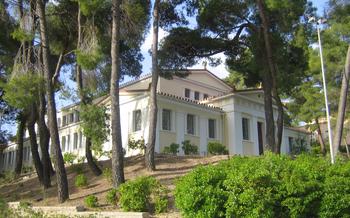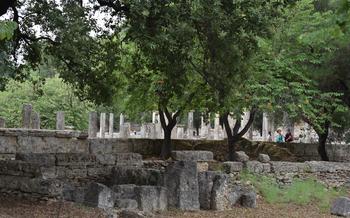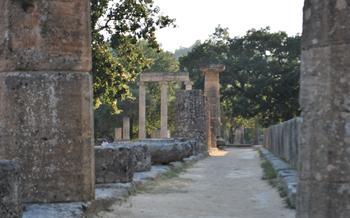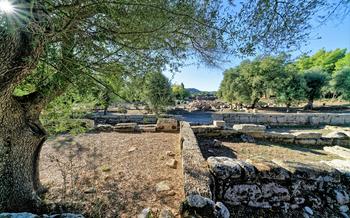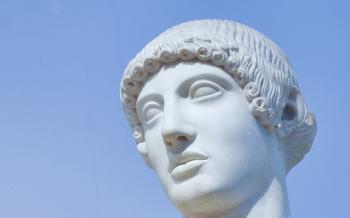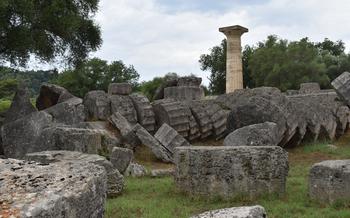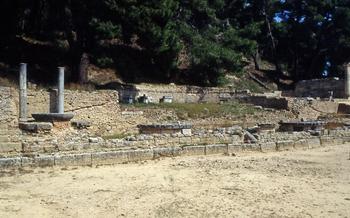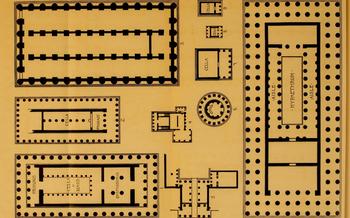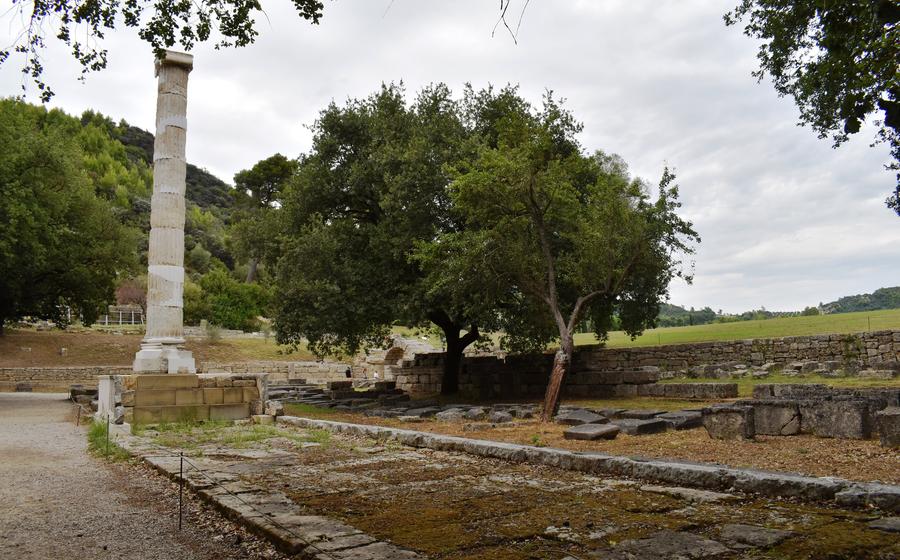
Loutra Killinis Roman Baths
- The Antiquity of Loutra Killinis Roman Baths
- Location and Accessibility of the Baths
- Historical Context and Significance
- Exploring the Baths: A Journey Through History and Architecture
- Thermal Springs and Their Benefits
- Festivals and Events: A Fusion of History and Culture
- Accommodation and Dining Options
- Tips for Photography Enthusiasts
- Sustainable Tourism Practices
- Local Customs and Etiquette
The Antiquity of Loutra Killinis Roman Baths
The Loutra Killinis Roman Baths stand as a testament to ancient Greece's rich history and the enduring legacy of the Roman Empire. Constructed during the 1st century AD, these remarkable baths hold immense historical significance, as they served as a sanctuary of relaxation and rejuvenation for weary travelers, athletes, and pilgrims seeking solace in the healing waters of the thermal springs.
Over the centuries, the baths fell into disrepair and were eventually buried beneath layers of soil and vegetation. It was only in the late 19th century that archaeological excavations brought these magnificent ruins back to light, revealing the grandeur and opulence of this once-thriving bathing complex.
The Loutra Killinis Roman Baths showcase impressive architectural features that reflect the ingenuity and craftsmanship of the Roman builders. With their vaulted ceilings, intricate mosaics, and elegant statues, these baths were a marvel of engineering and artistry. Their well-preserved state allows visitors to step back in time and imagine the bustling atmosphere that once filled these halls.
The baths played a pivotal role in the Roman Empire, serving as a place of respite and rejuvenation for soldiers, officials, and travelers alike. They were also a center of social and cultural exchange, where people from all walks of life could gather to socialize, relax, and indulge in the therapeutic benefits of the thermal springs.
Location and Accessibility of the Baths
The Loutra Killinis Roman Baths are conveniently located just a short distance from the ancient city of Olympia, the birthplace of the Olympic Games. This proximity makes it an ideal destination for history and culture enthusiasts seeking a comprehensive exploration of the region.
Transportation to the Baths:
-
By Car: For those traveling by car, the baths are easily accessible via the Olympia-Pyrgos National Road. Ample parking is available at the site, ensuring a hassle-free visit.
-
By Public Transportation: For those relying on public transportation, regular bus services connect Olympia to the village of Loutra Killinis, where the baths are situated. From there, a short walk or taxi ride will take you to the site.
Surrounding Attractions:
In addition to the baths, the area surrounding Loutra Killinis offers a wealth of attractions for visitors to explore. The picturesque village itself, with its charming tavernas and shops, is worth a visit. Nearby, the stunning beaches of Killini and Zacharo beckon with their crystal-clear waters and golden sands, perfect for a refreshing dip or a leisurely stroll.
For those seeking further historical immersion, the ancient city of Elis, with its well-preserved theater and other ruins, lies just a short drive away. Nature enthusiasts will delight in the nearby wetlands of Kotychi, a haven for diverse wildlife and a popular spot for birdwatching.
Historical Context and Significance
During the Roman Empire's rule over Greece, approximately from 146 BC to 323 AD, the Loutra Killinis Roman Baths played a significant role. The Romans, known for their advanced engineering and appreciation for bathing culture, developed these baths as part of their urban infrastructure. These public bathing facilities were not merely places for personal hygiene but also served as centers for social interaction, leisure, and wellness.
The baths were ingeniously designed to harness the therapeutic properties of the thermal springs. The Romans believed in the healing powers of the mineral-rich waters, which were said to alleviate various ailments and promote overall well-being. As a result, the baths became a popular destination for those seeking relief from physical and emotional stress.
In addition to their practical and therapeutic value, the Loutra Killinis Roman Baths held cultural and religious significance. They were often integrated into religious ceremonies and festivals, where people would gather to pay homage to deities associated with healing and well-being. The baths were also venues for social gatherings, where people from different walks of life could mingle, exchange ideas, and forge connections.
Exploring the Baths: A Journey Through History and Architecture
As you step inside the Loutra Killinis Roman Baths, you embark on a journey through time, surrounded by the remnants of a once-thriving Roman spa complex. The baths were meticulously planned and designed, reflecting the architectural prowess of the Roman Empire.
The layout features separate sections for men and women, each with distinct rooms for different bathing rituals. The frigidarium, or cold room, was used for initial cleansing, while the tepidarium, or warm room, served as a transition space before entering the caldarium, or hot room. The caldarium was the heart of the baths, where bathers could relax and soak in the therapeutic thermal waters.
Throughout the complex, intricate mosaics and well-preserved statues adorn the walls and floors, offering glimpses into the artistic and cultural influences of the Roman era. These exquisite artworks depict scenes from mythology, nature, and everyday life, adding a touch of elegance and grandeur to the bathing experience.
To enhance your exploration, consider renting an audio guide or joining a guided tour. These informative resources provide valuable insights into the history, architecture, and significance of the baths, bringing the ancient world to life.
Thermal Springs and Their Benefits
The Loutra Killinis Roman Baths are renowned for their thermal springs, which have been revered for their therapeutic properties since ancient times. Originating from deep within the earth, these waters are rich in minerals, such as sulfur, calcium, and magnesium, contributing to their healing and rejuvenating qualities.
In ancient Greece, these thermal springs were believed to possess divine powers and were often associated with deities like Apollo and Asclepius. The Romans, too, recognized their medicinal value and constructed elaborate bath complexes around them, allowing people to bathe and soak in the mineral-rich waters.
The therapeutic benefits of the thermal springs at Loutra Killinis are manifold. They are known to alleviate muscle pain, reduce inflammation, improve circulation, and promote relaxation. Bathing in these waters can also help with skin conditions, such as psoriasis and eczema, and alleviate respiratory ailments.
In modern times, the Loutra Killinis Roman Baths have been transformed into a modern-day wellness center, offering a variety of spa treatments and therapies that harness the healing power of the thermal springs. Visitors can indulge in soothing massages, detoxifying mud baths, and rejuvenating hydrotherapy sessions, all while enjoying the tranquil ambiance of the ancient Roman baths.
Festivals and Events: A Fusion of History and Culture
Loutra Killinis Roman Baths, a site steeped in antiquity, comes alive during cultural events and festivals, offering visitors a unique blend of history and local traditions. Throughout the year, the baths serve as a vibrant stage for a variety of celebrations that showcase the rich cultural heritage of the region.
Traditional Greek music and dance performances fill the air, transporting visitors back in time to the era of ancient Greece. The rhythmic melodies and graceful movements create a captivating atmosphere, allowing visitors to experience the vibrancy and passion of Greek culture.
Food and craft fairs are another highlight of these events. Local vendors display their culinary creations, offering a tempting array of traditional Greek delicacies. Visitors can savor the flavors of freshly baked pastries, succulent grilled meats, and delectable sweets while browsing handmade crafts that reflect the region's artistic traditions.
These festivals provide an exceptional opportunity for cultural immersion, enabling visitors to connect with the local community and gain a deeper understanding of Greek customs and traditions. Whether it's learning about traditional dances, sampling regional cuisine, or engaging in lively conversations with locals, these events offer a truly authentic and enriching experience.
Accommodation and Dining Options
For a convenient and immersive experience, consider staying at one of the nearby hotels or guesthouses that offer a range of options to suit different preferences and budgets. From traditional Greek villages to modern resorts, there's something for every traveler.
Indulge in the delectable flavors of Greek cuisine at the traditional tavernas and restaurants in the vicinity. Savor the freshest seafood, succulent grilled meats, and traditional dishes prepared with local ingredients. Vegetarian options are also available, ensuring that everyone can enjoy the culinary delights of the region.
Don't miss the opportunity to try local specialties such as the aromatic moussaka, the tangy tzatziki, and the sweet honey-soaked baklava. Whether you prefer a casual dining experience or a fine-dining establishment, you'll find plenty of options to satisfy your taste buds.
For those with dietary restrictions, the restaurants in the area are accommodating and can cater to specific needs. Vegetarian and vegan options are becoming increasingly popular, and many establishments offer a variety of dishes to suit different dietary preferences.
Tips for Photography Enthusiasts
For photography enthusiasts, the Loutra Killinis Roman Baths offer a wealth of captivating subjects and stunning backdrops. To capture the essence of this ancient site, consider arriving early in the morning or late in the afternoon when the soft, golden light casts a warm glow on the ruins. Experiment with different camera settings and composition techniques to highlight the intricate architectural details, the play of light and shadow, and the surrounding natural beauty. Use a wide-angle lens to capture the grandeur of the baths, or zoom in on specific features such as mosaics, statues, or inscriptions to reveal their intricate artistry. Don't forget to play with different angles and perspectives to create dynamic and visually appealing shots.
Sustainable Tourism Practices
When visiting the Loutra Killinis Roman Baths, it is essential to be a responsible traveler and minimize your environmental impact. Here are some sustainable tourism practices to keep in mind:
Respect the Environment:
- Avoid littering and dispose of waste properly in designated bins.
- Respect the natural surroundings and avoid disturbing wildlife.
- Opt for walking or cycling instead of driving to reduce carbon emissions.
Support Local Businesses:
- Choose locally-owned restaurants, cafes, and shops to support the local economy.
- Purchase souvenirs and handicrafts from local artisans to promote traditional crafts.
- Engage with local tour guides and learn about their culture and history.
Preserve Cultural Heritage:
- Respect the historical significance of the site and refrain from touching or damaging any artifacts or structures.
- Follow designated paths and avoid walking on sensitive areas.
- Be mindful of noise levels and avoid disturbing other visitors or local residents.
Local Customs and Etiquette
When visiting Loutra Killinis Roman Baths, it is important to be respectful of local customs and traditions. Dress modestly and appropriately, avoiding revealing or overly casual clothing. When interacting with locals, be polite and show genuine interest in their culture. A warm smile and a friendly greeting can go a long way. Tipping is customary in Greece, so leave a small gratuity for services rendered. Familiarize yourself with local customs and traditions to avoid any misunderstandings. For example, it is considered rude to point your finger at someone or to speak loudly in public. By being respectful and mindful of local customs, you can ensure a positive and enriching experience for yourself and those around you.
